Ijraset Journal For Research in Applied Science and Engineering Technology
- Home / Ijraset
- On This Page
- Abstract
- Introduction
- Conclusion
- References
- Copyright
Artificial Neural Network Based Load Forecasting
Authors: Shweta Singh
DOI Link: https://doi.org/10.22214/ijraset.2022.40467
Certificate: View Certificate
Abstract
In this report our point is to figure the power costs as precisely as conceivable by planning a half and half model and utilizing different blunder capacities to really take a look at the exactness of our outcome. Before liberation come to presence years and years back, the electric power enterprises have been overwhelmed by utilities that had full command over movements of every kind nearby. In any case, after its first endeavor in Latin America, the business has been on the move in many nations all over the planet. In a liberated market, end-use clients have the decision to choose their power provider.
Introduction
I. INTRODUCTION
For hundred years there was a regulated electric power industry throughout the world. In regulated market in one area only one company or government agency that produced, transmitted and sold electric power and services. Regulated market governed by vertically integrated utilities. So there was monopoly (that means consumers had no choice to choose their commodities supplier) of government companies in regulated electric market. In early 90’s reforms of power market started which included restructuring and unbundling of electric market. Reforms were based on privatization of electricity market. Chile was the first country in which restructuring of market started, followed by some Latin American countries and spread across the world. “Forecasting is a tool used for predicting future demand based on past demand information.” Forecasting is an essential planning tool that assists the decision-makers and planners to visualize and plan the future of the system according to their necessity. In electricity market, price and load forecasting are the two major planning tools for generation, transmission and distribution systems. Forecasting is the process of making statements about events whose actual outcomes (typically) have not yet been observed.
II. ARTIFICIAL NEURAL NETWORK BASED FORECASTING MODELS
It is seen in writing that old style models, i.e., AR, MA, ARMA and ARIMA models, otherwise called time-series or Box-Jenkins models, are very little fitting for transient value anticipating (STPF) in ebb and flow climate of high non-linearity and various irregularity. As a rule, they produce estimating blunder (MAPE) over 10%. Additionally, it saw that the old style models fundamentally require stationarity in time series information. Yet, the time-series value information in genuine are never fixed, the training to change over these time-series information to roughly fixed time-series information, to get estimated value determining, adds stationarity. Along these lines, old style determining models sometimes fall short for STPF. Computerized reasoning (AI) strategies are tracked down performing admirably, all things considered, issues. These strategies remove the covered up or innate relationship inside the information series, which can't be investigated effectively by straightforward time-series anticipating models. In the writing AI-based strategy i.e., Artificial Neural Networks (ANN) is broadly utilized for STPF. This strategy gives the most ideal decisions to anticipating with non-direct conduct of the value information.Because of liberation in the power market, and expanded rivalry among power age organizations, cost of the power assumes a significant part for these organizations. They need to create the power on serious costs, with great quality. In this manner the peculiarity's like power age; value variety, load request and so on are exceptionally unique in nature, which need an extremely exact estimating. Alluding to broad writing accessible on AI-based value anticipating models, it is induced that ANN is one of the most appropriate method to be used for value guaging. Consequently, different ANN-based value determining models are created and worked on in this theory work.
Generally utilized actuation (move) capacities are Sigmoid, Gaussian and other non-direct capacities. It is chosen based on kind of organization structure, though, a feed forward NN can be prepared utilizing tansigmoid, log-sigmoid and straight actuation capacities.
These actuation capacities are given as following:
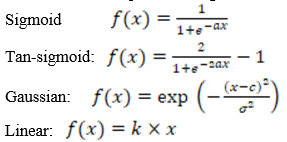
Where c and σ are the middle and width of Gaussian enactment capacity and k is a consistent, characterizing the slant of the line.
A. Learning Algorithms for ANN
A few learning calculations exist in the writing for preparing fake neural organizations and each preparing strategy is the most ideal for various kinds of issues. In the proposed work different preparation calculations are tried to track down the most ideal preparation calculation for anticipating the power cost precisely with least MAPE and ready to observe the right connection between input series and the power cost.
The preparation calculations considered in this paper are:
B. Conjugate angle Calculation with Powell-Beale Restarts
The inquiry course is occasionally reset to the negative of the inclination and it happens when the quantity of emphasess is equivalent to the quantity of organization boundaries (loads and predispositions). Powell proposed one such technique which depended on a previous strategy proposed by Beale. In this technique in the event that the symmetry left between the current inclination and the past slope is next to no the calculations restarts. The disparity (1) is utilized to test for the symmetry.

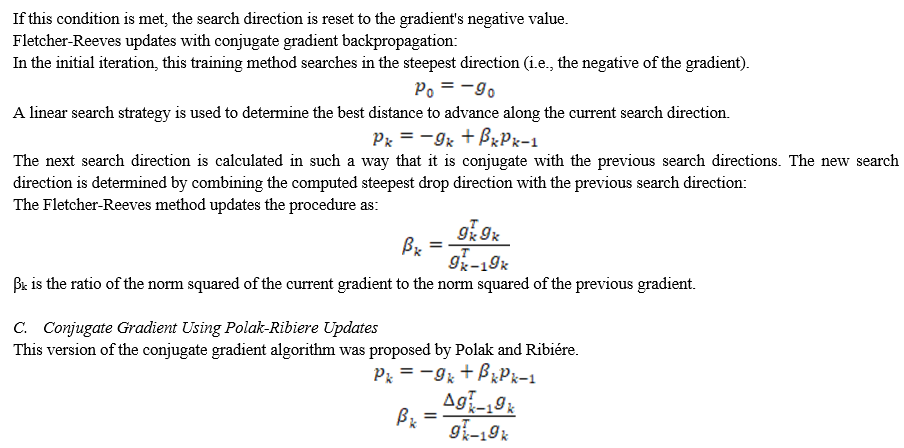
In this algorithm βk, If updated as indicated in the norm squared of the prior gradient is divided by the inner product of the previous change in the gradient with the current gradient.
D. Resilient Back Propagation
Sigmoid exchange work is ordinarily utilized in Multilayer feed forward networks in the secret layers, for crushing the limitless information range into a limited result range.
The incline of the sigmoid capacities will in general become zero for the huge information. The steepest plummet calculation while preparing the multi-facet organization can make the size of the angle tiny and hence, it cause little changes in the loads and predispositions, despite the fact that the loads and inclinations are a long way from their ideal qualities. The tough back proliferation preparing calculation invalidates the unsafe impact of progress in extent of the incomplete subsidiaries. The heading of the weight update in this not entirely settled by the indication of the halfway subordinate and not by the greatness of the subsidiary.
The adjustment of size of the weight is resolved utilizing a different update esteem, the loads and inclinations are expanded by delta_inc if, the presentation work subordinate has same sign as for that load for two successive cycles and the size is diminished by delta_dec assuming the exhibition work subsidiary has different sign concerning that weight sign from the previous emphasis.
The loads and inclinations are not refreshed for zero subordinates and the adjustment of size turns out to be enormous in the event that the adjustment of worth of the weight is in similar course for quite some time.
E. Scaled form inclination Algorithm
In this calculation, the upsides of weight and predilection are refreshed using the scaled form angle technique. This computation can be used to properly prepare networks with no subordinate capacity for their weight, net information, and move capacities. Back-engineering is used to determine the execution work subordinates for weight and inclination considerations. Using the wavelet change as a pre-handler. There are two sorts of Wavelet Transform (WT): constant and discrete. In the extent of this theory, we are worried about the discrete WT simply because we need to manage time series estimated at discrete time focuses .
The power value The series features value spikes, making it difficult to figure out. The wavelet change is a technique that converts a set of poorly performed value series into a set of constitutive series that has better properties and can thus be predicted more effectively and precisely. Because of the separating effect of the wavelet change, the series is divided into low recurrence and high recurrence sections, which are referred to as surmised and detail series, respectively. Persistent wavelet changes (CWT) and discontinuous wavelet changes (DWT) are the two types of wavelet changes (DWT).

III. PARTICLE SWARM OPTIMIZATION (PSO)
Swarm Intelligence (SI) is a creative, widely distributed intelligent viewpoint for addressing advancement difficulties that was inspired by the organic models of vertebrates amassing, rushing, and crowding oddities.
Molecule Swarm Optimization (PSO) consolidates amassing practices saw in groups of birds, schools of fish, or bee hives, and, surprisingly, human social conduct, from which the thought is arisen. PSO is a populace based streamlining apparatus, which could be executed and applied effectively to tackle different capacity advancement issues, or the issues that can be changed to work improvement issues [23]. As a calculation, the principle strength of PSO is its quick intermingling, which contrasts well and numerous worldwide improvement calculations like Genetic Algorithms (GA), Simulated Annealing (SA) and other worldwide streamlining calculations. While populace based heuristics are all the more exorbitant due to their reliance straightforwardly upon work esteems rather than subsidiary data, they are anyway helpless to untimely intermingling, which is particularly the situation when there are numerous choice factors or aspects to be improved. Taking everything into account, the arrangement swarm is compared to the bird swarm; the birds' movement from one spot to the next is analogous to the advancement of the arrangement swarm; great data is analogous to the most positive thinker arrangement; and the food asset is analogous to the most confident person arrangement throughout the course.
With everyone's help, the most confident person arrangement can be figured out in a molecular swarm advancement calculation. The molecule with no quality or volume fills in for each individual, and the basic code of behaviour is enforced for each molecule to demonstrate the complexity of the complete molecule swarm. Particles, which are potential arrangements, fly through the problem space in PSO by adhering to the most recent optimal particles Every particle keeps track of its directions in the problem space that are related to the best arrangement (health) that has been achieved thus far. This value is referred to as pbest. Another best worth followed by the molecule swarm analyzer is the best worth obtained over such a lengthy distance by any molecule in the molecule's neighbours. This value is referred to as lbest. The best worth is a worldwide best and is called gbest whenever a molecule accepts all of humanity as its topological neighbours. The molecular swarm enhancement concept entails altering the speed of each molecule toward its pbest and lbest values at each time step (for lbest rendition). The amount of time it takes to improve your speed is proportional to the amount of time it takes to irregular term, with independent arbitrary numbers being created for speed increase towards pbest and lbest areas.
In the wake of observing the best qualities, the molecule refreshes its speed and positions with following conditions .

IV. RESULTS AND COMPARISON
Comparison between various training algorithm results
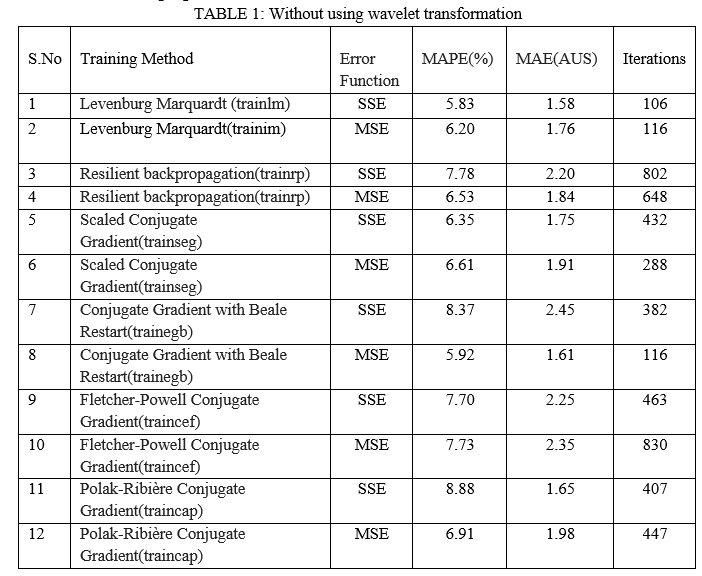
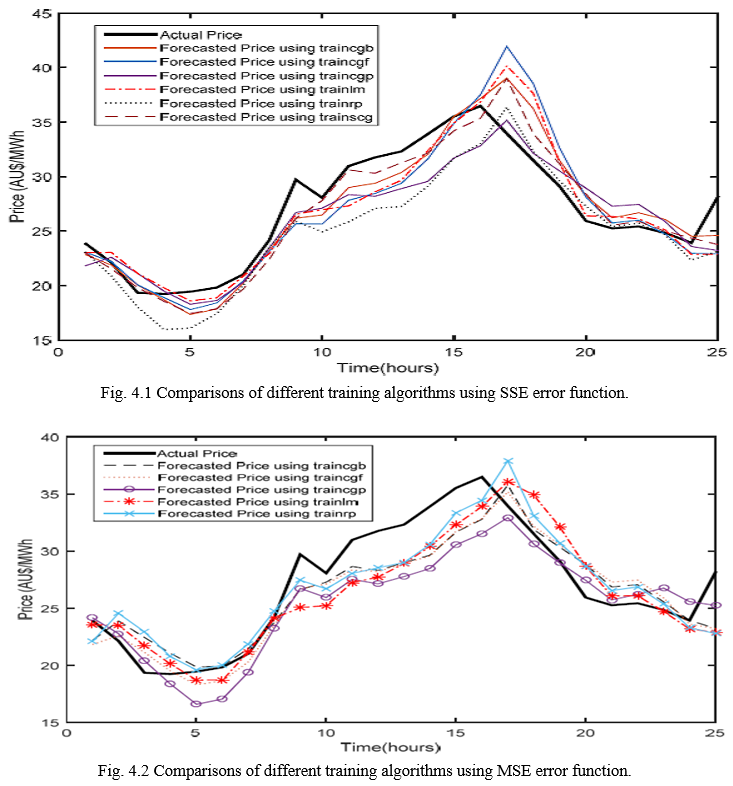
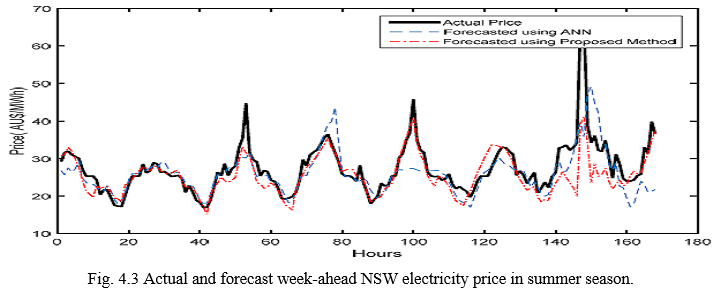
Conclusion
A precise determining power cost is a vital issue of worry for all market members, either for creating offering techniques, or for settling on speculation choices. In this proposition, a neural organizations model was proposed for value anticipating. The exhibition of the proposed model is checked utilizing New South Wales (NSW) power value information. Fake neural organizations innovation is a promising strategy for power value anticipating due to its strong capacity in nonlinear reproduction. In this postulation report, a multi-facet perceptron fake neural organizations model is built for dayahead power value anticipating in liberated electrical power market. By the outcomes found in this work it tends to be presumed that the proposed models have produced sensibly great gauge results. The preparation of the neural organizations with various preparation calculations and mistake capacities gives the agreeable outcomes. The value information is profoundly unpredictable and non-fixed in nature which should be adjusted for better guaging results. Wavelet change is utilized for information separating. I have carried out the ANN model and Wavelet-ANN model for power value determining with various preparation calculation. The blunders can be limited utilizing crossover models which is the mix of PSO with ANN. To upgrade the loads of neurons molecule swarm enhancement (PSO) procedure has been utilized.
References
[1] Murthy, Girish Godekere Panchakshara, Vijayalakshmi Sedidi, Ajaya Kumar Panda, and Badri Narayan Rath. “Forecasting Electricity Prices in Deregulated Wholesale Spot Electricity Market-A Review.” International Journal of Energy Economics and Policy 4, no. 1 (2013): 32–42. [2] Prabavathi, M., and R. Gnanadass. “Bidding Strategies for Indian Restructured Power Market.” In Circuits, Power and Computing Technologies (ICCPCT), 2013 International Conference on, 568–73.IEEE, 2013. [3] Sharma, N. K., P. K. Tiwari, and Y. R. Sood. “Current Status, Policies and Future Perspectives of Indian Power Sector Moving towards Deregulation.” In Electrical, Electronics and Computer Science (SCEECS), 2012 IEEE Students’ Conference on,1–6.IEEE,2012. http://ieeexplore.ieee.org/xpls/abs_all.jsp?arnumber=6184730. [4] V. P. Gountis and A. G. Bakirtzis, “Bidding strategies for electricity producers in a competitive electricity marketplace,” IEEE Transactions on Power Systems, vol. 19, no. 1, pp. 356–365, February 2004. [5] Hamidreza Zareipour, “Price Forecasting and Optimal Operation of Wholesale Customers in a Competitive Electricity Market,” Ph.D. dissertation, Dept. Electrical and Computer Eng., Univ. of Waterloo, Canada, 2006. [6] Shahidehpour, M., Yamin, H., and Li, Z. (2002), Market operations in electric Power systems: forecasting, scheduling, and risk management: Wiley. [7] Weron, R. (2006). Modeling and forecasting electricity loads and prices: a statistical Approach, Chichester: Wiley. [8] Zareipour, H. (2008), Price-based energy management in competitive electricity markets VDM Verlag Dr.Muller.
Copyright
Copyright © 2022 Shweta Singh. This is an open access article distributed under the Creative Commons Attribution License, which permits unrestricted use, distribution, and reproduction in any medium, provided the original work is properly cited.

Download Paper
Paper Id : IJRASET40467
Publish Date : 2022-02-23
ISSN : 2321-9653
Publisher Name : IJRASET
DOI Link : Click Here
 Submit Paper Online
Submit Paper Online

